The Mahonia Debate
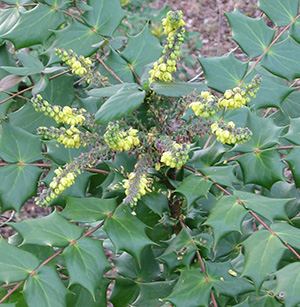
A closer look at Mahonia and its classification
Mahonia is a genus of about 100 species of shrubs or small trees native to Asia, North America, and Central America. They have compound leaves, yellow (often fragrant) flowers, and blue-purple to black berries. For more than 200 years, botanists have known that Mahonia plants are closely related to Berberis, and some have argued that all species of Mahonia should be transferred to the genus Berberis. Recent studies provide genetic, morphological, and ecological evidence to support recognizing Mahonia as a distinct group. Botanists still are not in agreement on this, so you might see cultivated Mahonia listed under either genus. Below are the species most frequently cultivated in Florida.
Fortune’s Mahonia (Mahonia fortunei)
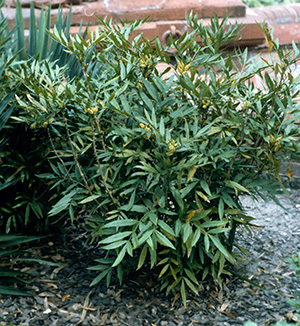
John Ruter, University of Georgia, Bugwood.org
Mahonia fortunei, also known as fortune’s mahonia or Chinese mahonia, is also sometimes classified as Berberis fortunei. Fortune’s mahonia is listed as Florida-Friendly and grows in Central and North Florida. It is an evergreen shrub on the shorter side, growing 5 to 6 feet tall and wide. From late summer into fall, it produces multiple short, cylindrical flower stalks, with small, tightly clustered yellow flowers. The leaflets are narrow and linear, with soft-spined margins, giving the leaves a delicate, fern-like appearance. The branches drape down to make the plant appear rounded. Fortune’s mahonia prefers shade but can also be grown in partial sun. It can serve as a border or hedge plant when planted in groups, or act as a feature plant when planted alone. Its blue-purple berries and yellow flowers attract a host of wildlife species, including bees, butterflies, hummingbirds, and songbirds.
Leatherleaf Mahonia (Mahonia bealei)
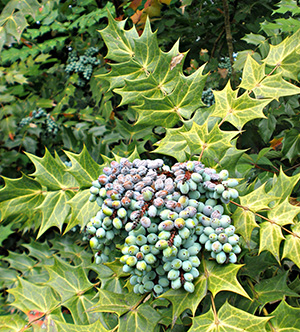
Mahonia bealei, also known as leatherleaf mahonia, is sometimes classified as Berberis bealei. Leatherleaf mahonia is an upright, sprawling, multi-stemmed evergreen shrub reaching 5 to 10 feet in height and 3 to 4 feet wide. It is drought tolerant and moderately salt tolerant. While it requires a few hours of sun daily to flower, do not plant in full sun as this will bleach its foliage. This prickly shrub develops grape-like purple-blue fruits in the summer and very fragrant, yellow flowers in spring and winter, attracting pollinators as well as birds. This species has broader, more leathery leaflets than fortune’s mahonia. Leatherleaf mahonia also has hard, sharp spines on the leaf margins that resemble those of some holly plants. It should be noted that while this plant does well in North or Central Florida, it has not yet been evaluated by the UF/IFAS Assessment of Non-native Plants and is considered invasive in other southeastern states. This shrub has been documented to have escaped cultivation and has become established in the wild throughout the Southeast.
Soft Caress Mahonia (Mahonia eurybracteata ‘Soft Caress’)
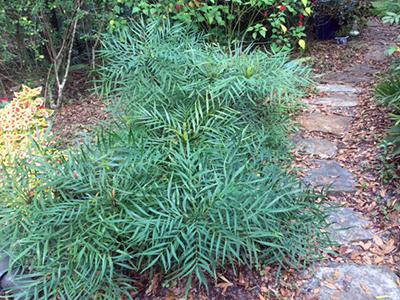
The only cultivar of Mahonia eurybracteata cultivated in the U.S. is ‘Soft Caress’, introduced to the market in 2002. This small, woody shrub, also classified as Berberis eurybracteata, grows 3 feet tall and spreads 3 to 4 feet wide. As the cultivar name suggests, it is much “softer” than the other mahonia plants and has finely textured leaves with narrow leaflets that lack sharp-spined margins. As a result, it is much easier to handle and prune. ‘Soft Caress’ is well-suited for areas in the landscape that receive partial shade.
Oregon Grapeholly (Mahonia aquifolium)
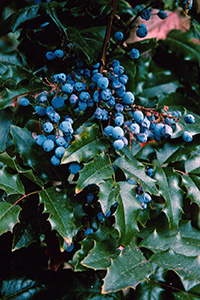
Mahonia aquifolium, also known as Oregon grapeholly, is sometimes referred to as Berberis aquifolium. This plant is the state flower of Oregon, which is where it gets its common name. Despite its resemblance to both plants, Oregon grapeholly is not a true grape or holly as the name suggests. While fun to look at, this shrub is found in the Pacific Northwest and not recommended for Florida.
These intriguing, wildlife-friendly plants continue to catch the attention of botanists and gardeners alike. Scientists sometimes update plant classifications based off current research; as discussions evolve, species of Mahonia might experience relevant name changes.
